Examining Manapo Hospital's Struggle for Basic Services
 Ovayo Swartbooi
Ovayo Swartbooi
The Mofumahadi Manapo Mopeli Hospital (Manapo Hospital) in Phuthaditjhaba (QwaQwa) hasn't had reliable water since 2018. I would know—I lived in their quarters. At the time, our staff homes were serviced by a single Jojo tank shared with the hospital and nursing college.
The Mampoi Road leading to the entrance was riddled with potholes, and you’d be hard-pressed to find a five-meter stretch of intact tar. Yet, just a stone's throw away lies the magnificent Golden Gate National Park, located in the Maluti mountain range between Harrismith and Clarens. This international tourist destination is particularly famous for its glorious cabins that come alive in winter.
The Thabo Mofutsanyana District Municipality is a story of infrastructural failure. Less than half of its residents have access to bulk sewerage and water, and some recall last having electricity in 2016. Interestingly, Manapo Hospital sits adjacent to the Maluti Crescent (Setsing) Mall, which received major upgrades initiated in 2022, totaling R200 million over 16 months.
The Maluti-a-Phofung executive mayor attended the sod-turning event in 2022. One wonders—did he not get the dry-taps memo next door? Apparently not.
Health-e News recently reported a pregnant patient from Manapo Hospital saying, “...Some patients walk to Setsing to buy or fill their bottles (with water).” This comes on the back of an allegation that the same hospital ran out of diesel during a power outage last week, leading to the death of a 58-year-old woman who was on life support.
Dr. Patricks Otomo of the Faculty of Agricultural Sciences at the University of Free State stated, “There is water in Qwaqwa. What is lacking is the proper upgraded infrastructure to harvest, treat, and redistribute this water to the community.”
Why QwaQwa struggles with water and electricity 30 years into democracy is unclear. What is clear is that the people of QwaQwa have lacked a local government capable of executing its mandates. Building institutional capacity is complex, requiring stakeholders to play the long game.
Here are my thoughts on how it could be done:
First, start with the community. Community engagement is the most crucial step. An online comment from a desperate resident reads,
“I’m staying here in Tseki arrount Court , Police Station and clinic! But no electricity most of the time! Crime is so high! We need Apollo light right next to court which will light all surrounding areas. Pls help Apollo light pls. And we don’t have water since from 2016! Disgusting life. I love my qwaqwa with all of my heart but I’m sad! Get in the village’s streets you’ll see! Only grass and water ,mud! What kind of streets are that? Pls You those who are in power try to modify qwaqwa.” [sic]
Fostering community involvement in the planning, implementation, and monitoring of projects increases buy-in and promotes transparency and accountability.
Second, squash the corruption. In 2023, the Bethlehem Regional Court sentenced six individuals, including a local municipal official, after finding them guilty of defrauding the municipality through a skills development workshop and the installation of electricity meters. They were charged with corruption, fraud, and money laundering. The tenders had a combined value of R2 million.
Commissions and task forces charged with oversight play a critical role in ensuring municipalities do not fall prey to corruption. Supported by transparent procurement of services, this minimizes the risk of such crimes occurring.
Lastly, get serious about partnerships. Through strategic public-private partnerships, emphasis should be placed on projects that are viable, impactful, meaningful, and sustainable. The municipal government recently partnered with private investors on a multi-billion rand project dubbed the QwaQwa Gateway project. This project will see the construction of over 17,000 government prototype and bonded homes, student accommodation, a retail mall, a new hospital, and other amenities. The mammoth project, largely privately funded, will take over 10 years to complete.
I have fond memories of the community, where you discharge your patients and bump into them again hours later at Pep. My SeSotho is what it is because of them. I still turn my head when I hear someone shout “Ngaka!” May the people I served remain persistent and steadfast in their fight for service delivery and access to dignified healthcare
Subscribe to my newsletter
Read articles from Ovayo Swartbooi directly inside your inbox. Subscribe to the newsletter, and don't miss out.
Written by

Ovayo Swartbooi
Ovayo Swartbooi
🏥👩🏽⚕️Digital Health Consultant, Community Builder, SDG 3 and 9. 💡💭Emerging thought leader on Digital Health in Africa. 🌍I educate the world on how digital innovation can drive the delivery of value-based care on the African continent.